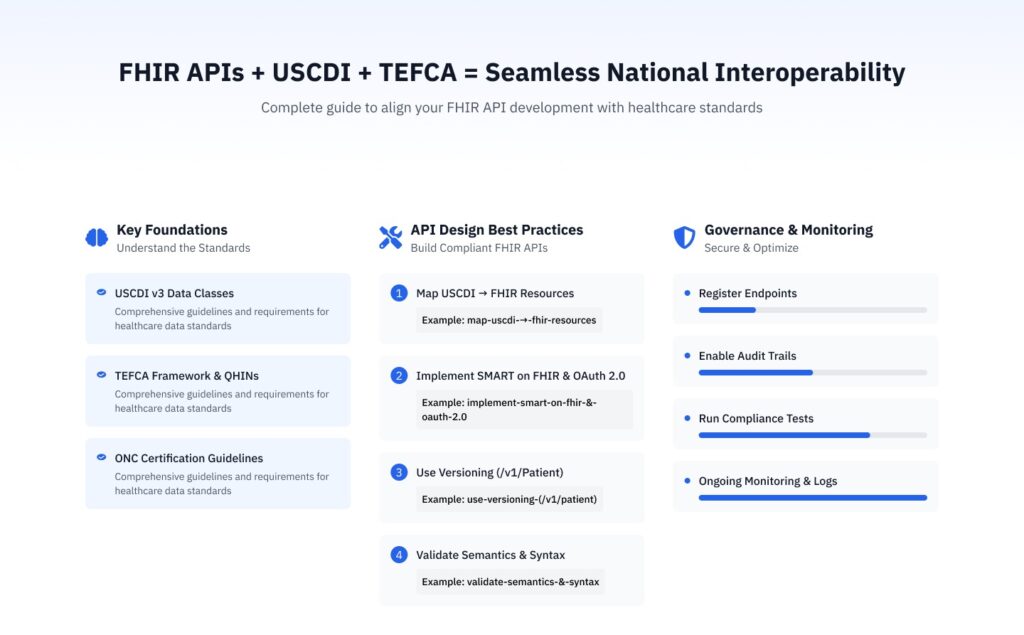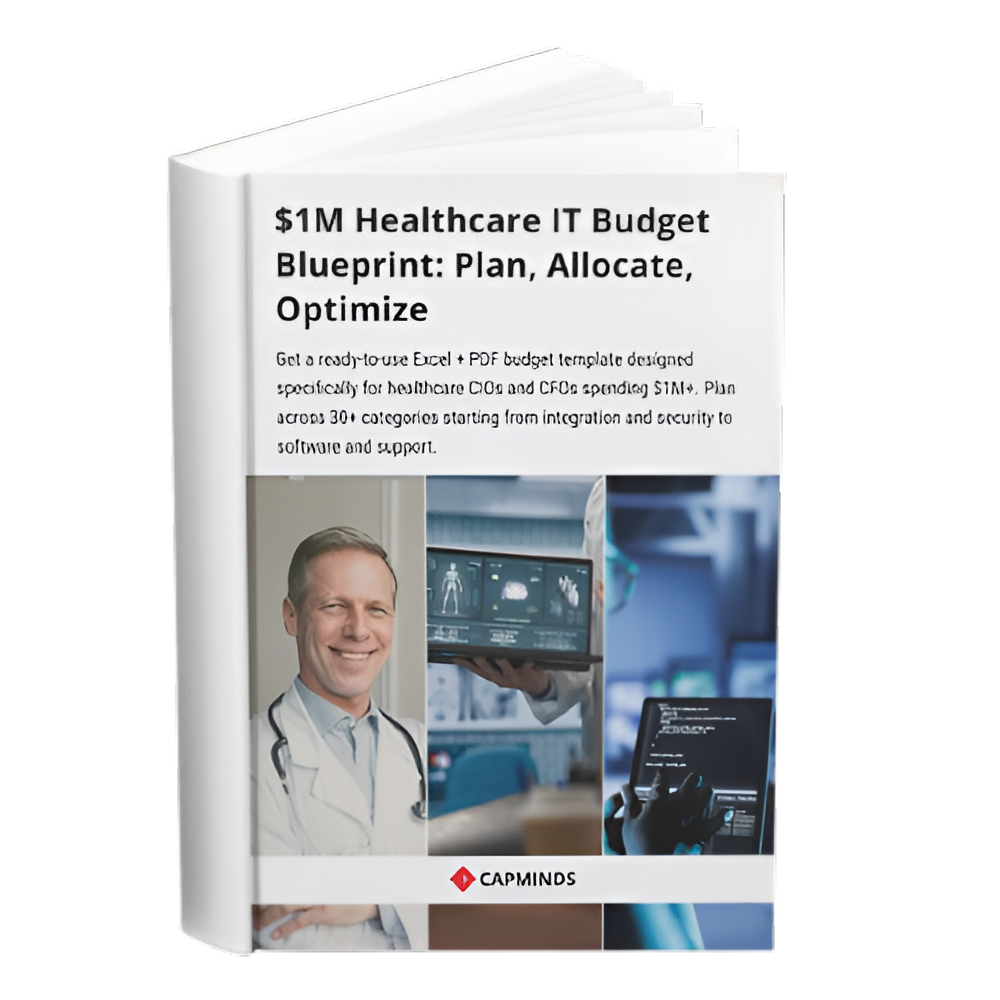How to Align FHIR API Development With USCDI and TEFCA Compliance
Interoperability is no longer an option; it’s a necessity in today’s healthcare. The combination of HL7 FHIR, US Core Data for Interoperability, and Trusted Exchange Framework and Common Agreement helps in sharing national health information.
For developers and health IT professionals, developing FHIR APIs by these standards necessitates a thorough grasp of regulatory regulations, data format, security, and governance rules.
In this blog, you’ll know the critical processes for creating FHIR APIs that are completely compliant with USCDI data standards and TEFCA regulations.
Overview of USCDI and TEFCA
Before entering development, it’s critical to understand the regulatory framework that influences healthcare interoperability. The USCDI is a standardized collection of health data classes and components developed by the Office of the National Coordinator for Health IT. Its goal is to ensure that a consistent and extensible dataset can be shared across multiple platforms.
TEFCA, established by ONC and maintained by The Sequoia Project, aims to create a national exchange system. It establishes a set of rules, processes, and technological standards to provide safe, scalable, and interoperable health data sharing across networks.
USCDI and TEFCA are more than simply policy checkboxes; they have a real impact on how FHIR APIs should be designed, protected, and scaled. Failure to comply might lead to integration hurdles as well as loss of certification or fines.
1. Design FHIR Resources Based on USCDI Data Classes
To align FHIR APIs with USCDI, the first step is to convert FHIR resources to USCDI data classes. USCDI contains structured data items including allergies, drugs, procedures, care team members, and so on.
- Connect each USCDI element, such as Patient Demographics, Immunizations, and Clinical Notes, to the associated FHIR resource Patient, Immunization, and DocumentReference.
- Ensure that read and write capabilities are enabled for the USCDI elements required by ONC.
- Update your data models to support the most recent version of USCDI, currently v3, and be ready for future updates.
Your APIs will be more full and semantically consistent across systems if they are designed with USCDI in mind.
2. Implement Smart Authorization using TEFCA Principles
TEFCA focuses on trust and exchange governance, whereas FHIR addresses data structure. TEFCA specifies specifications for Qualified Health Information Networks and assures that all participating systems adhere to strict security and privacy standards.
- Implement SMART on FHIR and OAuth 2.0 to provide patient-authorized data access.
- Ensure that auditing and consent tracking tools are built into your API gateway.
- Implement identity proofing and token validation mechanisms by NIST SP 800-63.
By including these trust services in your design, your APIs will be ready to connect to TEFCA-compliant exchanges and fulfill data access transparency requirements.
Related: FHIR, TEFCA & UDS+: How Enterprise-Scale Health Systems Are Gearing Up
3. Address Versioning and Evolving Requirements
FHIR is a dynamic standard, as is USCDI. New aspects are introduced with each iteration, and TEFCA standards may alter in response to national objectives or new ONC rules. As a result, versioning your FHIR APIs is not an option; it is required.
- Version your APIs like /v1/Patient, /v2/AllergyIntolerance to account for changes in data classes or resource definitions.
- Monitor ONC updates for new USCIS versions to guarantee backward compatibility.
- Use a modular design to provide upgrades without disrupting the entire application ecosystem.
Planning for flexibility protects your systems against potential compliance holes.
4. Validate Data Semantics and Syntax
Although your FHIR API theoretically supports USCDI fields, semantic and syntactic validation are required for real-world interoperability. TEFCA demands data that is not just accessible but also accurate and high-quality.
- Use FHIR validation tools to ensure compliance with basic profiles and implementation guidelines.
- Utilize terminology services to validate value sets and coding systems, such as SNOMED CT, LOINC, and RxNorm.
- Integrate unit tests and real-time validators into your CI/CD processes.
Without semantic integrity, your API will fail to offer meaningful data, no matter how “compliant” it seems on paper.
5. Ensure Endpoint Discoverability and Secure Exchange
One of TEFCA’s primary operating aims is to enable seamless data discovery across networks. This means that FHIR APIs must not only provide endpoints, but also register them with trusted directories.
- Register your FHIR server endpoints with National Endpoint Directories, as required by TEFCA QHIN rules.
- Use TLS encryption and mutual authentication mechanisms for all external connections.
- Use IHE profiles like IUA and ATNA to ensure safe audit trails.
These methods enable healthcare companies to interact securely and ensure trusted access in a TEFCA-enabled environment.
6. Document and Certify your FHIR Implementation
Documentation is more than simply good practice; it is frequently necessary for certification under ONC Health IT guidelines. It also facilitates collaboration with QHINs and third-party developers.
- Use Swagger, Postman, or ReDoc to provide developer-friendly API documentation.
- Include explicit directions for registering for the SMART App, exchanging tokens, and defining data scopes.
- Prepare your FHIR server for certification testing with tools such as Inferno and Touchstone.
Well-documented APIs save integration time and enable long-term collaboration in a federated data exchange context.
7. Consistently Monitor Compliance and Optimize
Once your FHIR APIs are live, the job does not cease. Continuous monitoring is required to ensure USCDI alignment and TEFCA preparedness.
- Logging and monitoring tools allow you to track API usage and performance.
- Conduct quarterly audits to evaluate your security posture and data exchange efficacy.
- Stay informed about FHIR community updates, ONC advice, and TEFCA regulation.
This proactive strategy guarantees that your FHIR APIs are current, secure, and compliant as the legal and technological landscapes change.
Build Compliant, Scalable FHIR APIs with CapMinds
At CapMinds, we don’t just build APIs, we engineer future-ready healthcare interoperability. Our end-to-end digital health solutions ensure that your FHIR APIs are fully compliant with USCDI v3, TEFCA exchange principles, and the latest ONC certification standards.
Whether you’re launching a new platform or modernizing legacy systems, we help you meet the highest data-sharing and compliance benchmarks.
Our FHIR and interoperability services include:
- FHIR API development aligned with USCDI data classes
- SMART on FHIR implementation with OAuth 2.0 security
- TEFCA-ready architecture and QHIN integration support
- Versioning and semantic validation of resources
- Endpoint registration with national directories
- Compliance audits & certification support
- FHIR API documentation and developer portal design
Let CapMinds power your next step in interoperability is secure, certified, and scalable from day one.





